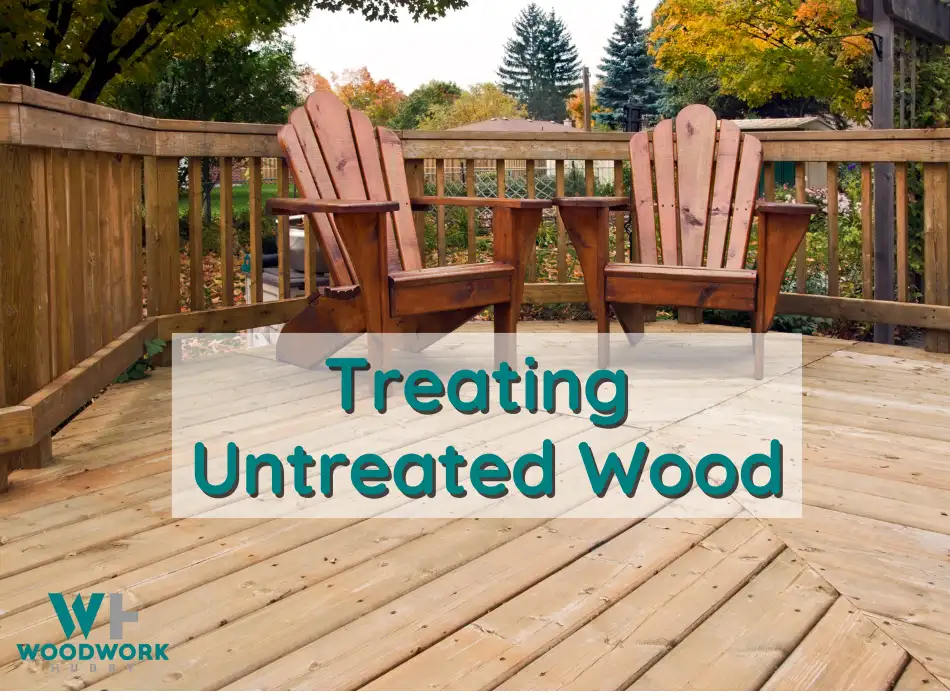A friend was asking me for some advice for an outdoor seat he was making. I gave him a shock when I said he had to use treated wood. Untreated wood can easily fall prey to harsh weather conditions, insect attacks, and decay if left unprotected.
In general, you can treat wood for outdoor use by applying sealers, oil, or varnish. There are other methods such as pressure treating which is a bit beyond most users.
I will guide you on how to treat untreated wood for outdoor use in order to ensure its longevity and maintain its natural beauty.
What I Recommend (Expert Tip!) 💭
The easiest and most effective products to apply are the sealer and oil listed below. I stock these products in my workshop and swear by them!
Why Treat Untreated Wood For Outdoor Use?
Treating untreated wood for outdoor use is critical since it provides protection against the elements, offers insect and fungal resistance, and increases its durability.
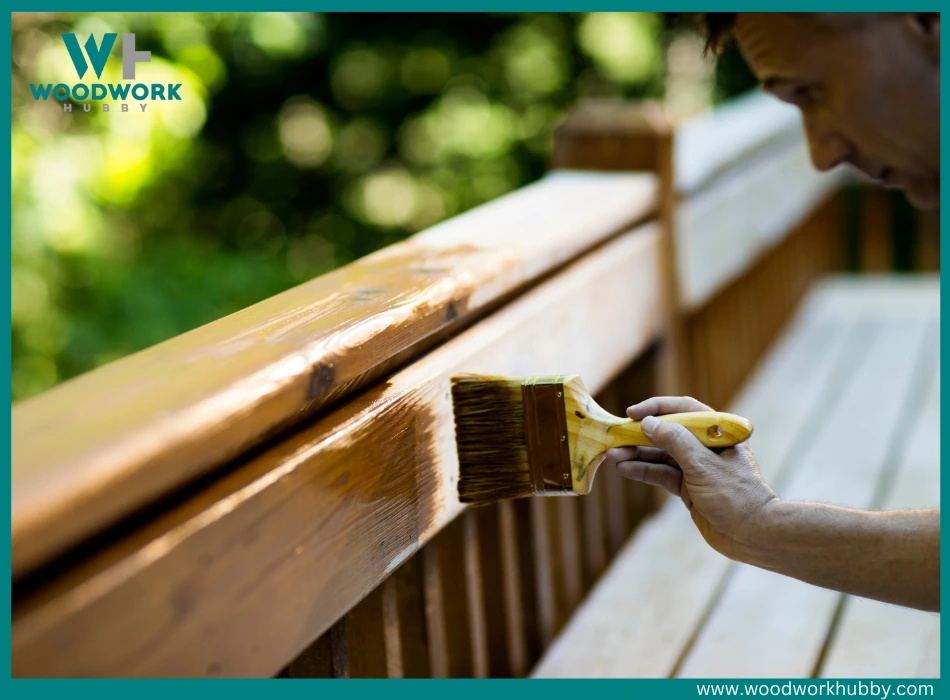
Protection Against Elements
One of the main reasons to treat untreated wood for outdoor use is to provide much-needed protection against various elements. By applying a suitable treatment like a wood sealer or oil finish, we can significantly enhance the wood’s natural resistance to water, moisture, and even harmful UV rays from the sun.
Treating your exterior wood projects also safeguards them against extreme temperature fluctuations that can cause warping and cracking over time.
Insect Resistance
One of the main benefits of treating untreated wood for outdoor use is insect resistance. A variety of pests, such as termites and carpenter ants, can wreak havoc on wooden structures by feeding on and damaging the wood.
For instance, using a spar urethane or an oil-based paint can add an extra layer of protection against insects by coating the surface with durable material.
Fungal Resistance
One of the primary reasons to treat untreated wood for outdoor use is to enhance its fungal resistance. Fungi are notorious wood-destroying organisms that can cause significant damage and compromise the structural integrity of your wooden exterior projects.
When moisture interacts with untreated wood, it creates a favorable environment for fungi growth.
To protect your outdoor wooden furniture, decking, or structures from these unwanted guests, it’s essential to choose an appropriate treatment method based on factors such as desired appearance and level of protection needed.
Wood sealers containing fungicides or mildewcides provide an effective barrier against fungi growth by sealing the surface pores and preventing moisture penetration.
Oil finishes like linseed oil, tung oil, and Danish oil offer some degree of protection by repelling water but may require more frequent maintenance compared to other treatments like stain-sealer combinations or varnishes that feature added UV sunlight protection and improved durability over time.
Find out from my extensive research if Linseed oil will stop wood from cracking.
Increased Durability
One of the main reasons why untreated wood needs to be treated for outdoor use is to increase its durability. When left untreated, wood can easily rot and decay due to exposure to elements such as moisture, fungi, insects, temperature changes, and sunlight.
Treating wood with a sealant or finish helps protect it by creating a barrier against these factors.
Properly treated wood for outdoor use can make it last up to 25 years or more. For example, pressure-treated woods undergo a commercial treatment process that involves heat and preservatives pressed into the wood making them resistant to weather and insects.
Soaking untreated wood in a borate solution or using copper coating stains or sealants can also help increase its durability for outdoor use.
Types Of Wood Treatments For Outdoor Use
Learn about the different types of wood treatments that can provide protection against the elements, insects, and fungal growth to increase the durability of your outdoor wooden structures.
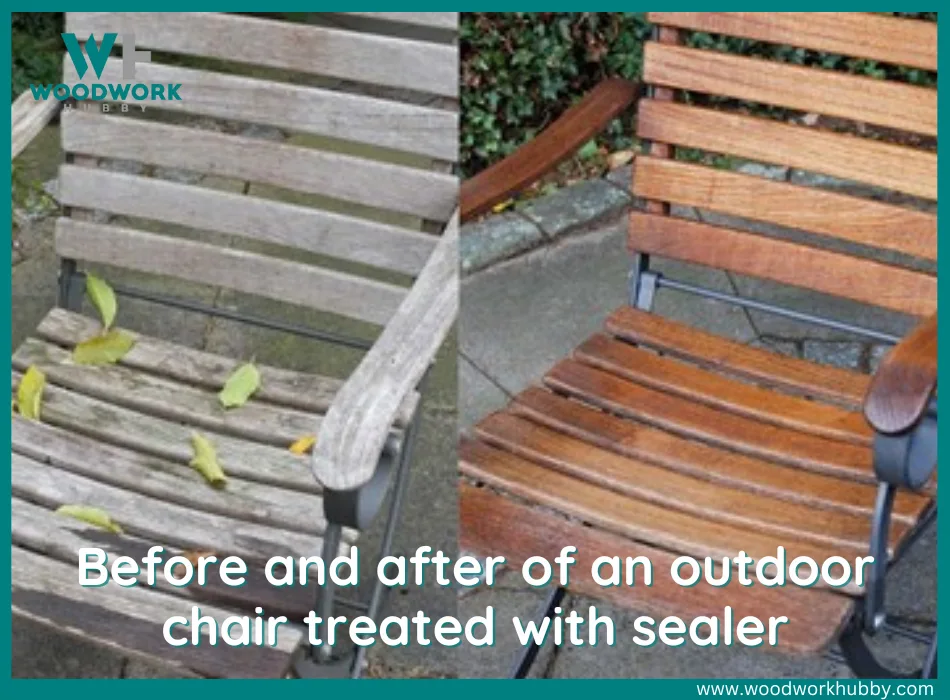
Wood Sealers
I highly recommend wood sealers as a treatment for untreated wood used outdoors. Wood sealers protect against the elements, insect and fungal growth, and increase durability.
They add a layer of waterproof protection to wooden surfaces to keep them looking new longer.
When choosing a sealer, it’s best to select an oil-based one over water-based ones since they are more durable and can withstand extreme temperatures better without cracking or peeling.
Some popular options include:
The proper application involves cleaning the surface before sanding it lightly with fine-grit sandpaper to remove roughness from any exposed fibers that could absorb moisture quickly.
Oil Finishes
I am a big fan of oil finishes for treating untreated wood for outdoor use. They are easy to apply and can provide excellent protection against the elements.
One of the most popular oils used is linseed oil, which penetrates deep into the wood fibers and creates a water-resistant barrier on the surface.
When applying oil finishes, it’s essential to do multiple coats until you achieve the desired finish. The first coat should be thin enough to allow proper penetration into the wood, while subsequent layers will add more protection and create a glossy shine over time.
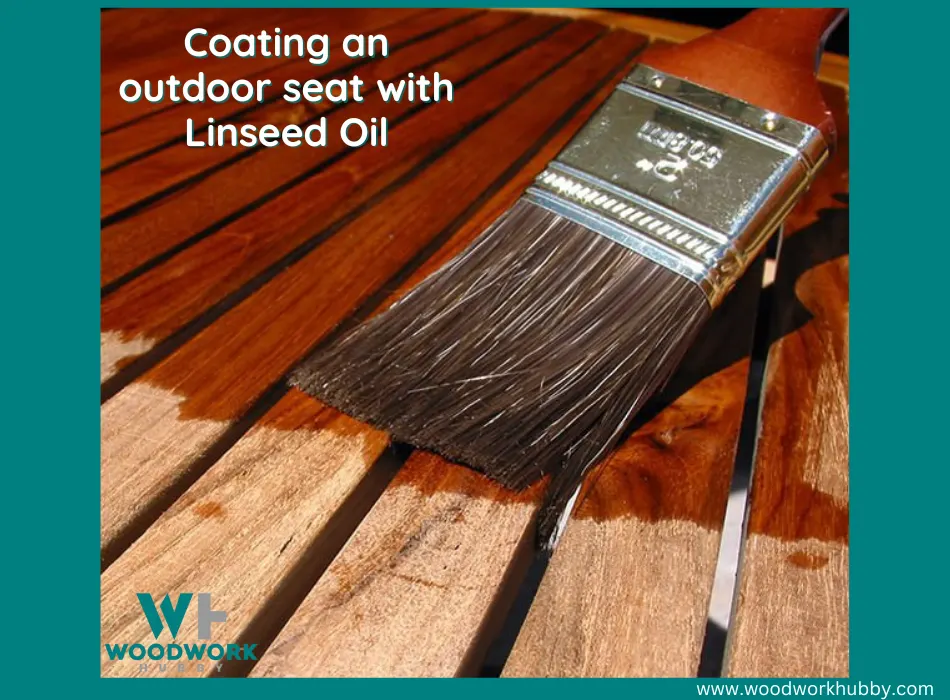
Stain-sealer Combinations
I have found that stain-sealer combinations are an excellent option for treating outdoor wood as they provide both protection and appearance. These products can hide imperfections in the wood surface while protecting it from weather, insects, and fungi.
One example of a quality stain-sealer combination is Thompson’s Water Seal. It provides advanced waterproofing protection while allowing the wood grain to show through.
Another popular product is Seal-Once, which uses nanotechnology to penetrate and bond with wood fibers, providing long-lasting protection against water damage and UV rays.
Varnishes
Varnish is an effective option for treating untreated wood for outdoor use. It creates a waterproof finish on the surface of the wood, protecting it from moisture and mildew growth.
Varnishes are available in various sheens, including glossy or satin. The choice of sheen will depend on your desired appearance and level of protection needed.
I have used varnish regularly in my woodworking projects to protect the wood from outdoor elements such as rain, wind, and sunlight damage.
However, be sure to apply multiple coats for maximum protection and durability.
Pressure Treatment
I highly recommend pressure treatment as a reliable way to protect your outdoor wood from pests, decay, and moisture. It is however difficult for most people to do.
The process involves using chemicals such as copper azole, alkaline copper quaternary, or other substances under high levels of pressure to penetrate the wood and preserve it.
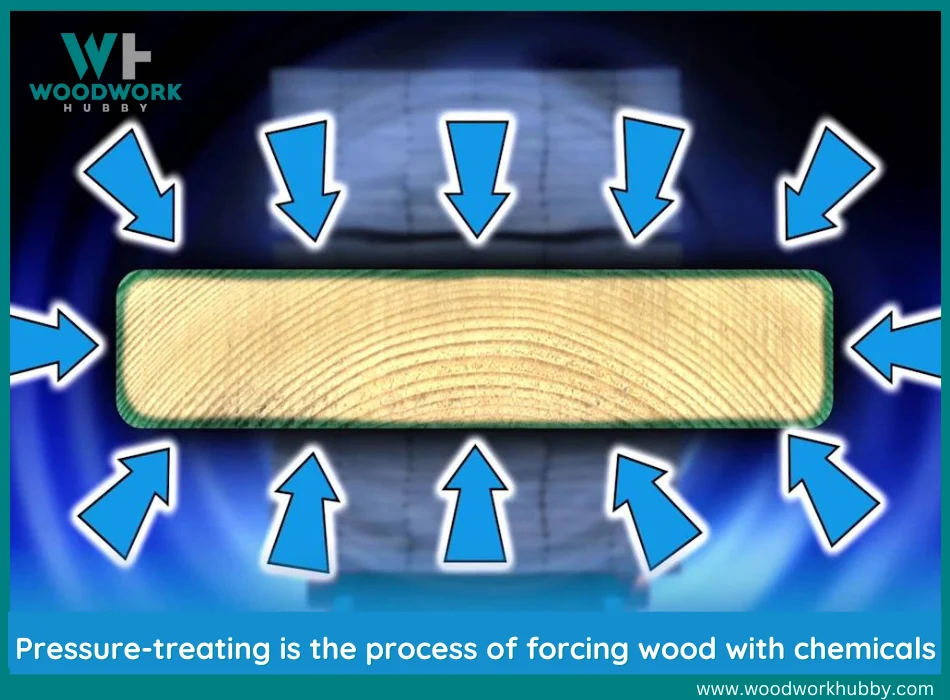
Pressure-treated wood lasts longer than untreated wood because it contains preservatives that create a barrier against insects and fungi. It also has greater resistance to weathering due to its natural waterproof properties.
See how to repair rotted wood with my full explanation of everything you need to do the job.
Best Methods For Treating Untreated Wood
The best methods for treating untreated wood for outdoor use include wood sealer application, varnish application, oil finish application, and pressure treatment process.
Wood Sealer Application
Applying wood sealer is one of the most common methods for treating untreated wood for outdoor use. To do this, start by cleaning the surface of the wood and sanding it lightly to create a smooth finish.
Make sure to remove any dust left from the sanding before applying the sealer evenly with a brush. Applying multiple coats may be necessary depending on the level of protection needed, but always allow drying time between coats.
Proper application of wood sealer can significantly increase overall durability by providing weather-resistant barriers against UV rays and mildew growth. Additionally, sealers are good at protecting wood from rotting or decaying due to moisture exposure.
Varnish Application
Applying varnish to untreated wood is a popular method for protecting outdoor wooden structures from the elements. Varnish creates a clear, glossy finish that’s ideal for enhancing the natural beauty of wood while providing protection against water, UV rays, and humidity.
It can also be used in combination with a stained-sealer to increase wood’s durability and longevity.
When applying varnish, it’s essential to work in a well-ventilated area as fumes can be harmful if not properly handled. Ensure that surfaces are thoroughly cleaned and sanded before application to ensure maximum adherence.
When applied correctly, varnished wood can last up to 25 years with proper storage and maintenance.
Oil Finish Application
Applying an oil finish to outdoor untreated wood is a great way to enhance the natural beauty of the wood while providing protection against the elements. There are different types of oils you can use, including linseed oil, tung oil, or Danish oil.
The application process typically involves wiping on one or two coats with a cloth, allowing it to soak in before wiping away any excess.
It’s important to note that there are some downsides when using an oil finish for outdoor use. Although they provide some level of water resistance and weatherproofing, they don’t hold up as well against UV rays compared to other treatments like varnishes and sealers.
Pressure Treatment Process
I’ve had a lot of success treating untreated wood for outdoor use with the pressure treatment process. This method involves placing the wood in a chamber and using intense pressure to inject chemicals into the fibers of the wood, making it resistant to rot, decay, insects, and weathering.
It’s important to note that some chemically treated woods may contain harmful toxins or heavy metals like arsenic or copper. When working with pressure-treated wood, it is essential to take proper safety precautions such as wearing protective gloves and masks and avoiding burning any sawdust or scraps from treated wood.
Additionally, keep in mind that certain types of paints or sealers may not adhere well to chemically treated woods due to their oily surface.
Tips And Tricks For Treating Exterior Wood
Check the weather before starting to ensure the wood is dry and will have enough time to fully dry after treatment; be sure to get the right equipment, including brushes, sprayers, sandpaper, and safety gear; apply multiple coats of sealant for better protection against the elements and increased durability.
Check The Weather Before Starting
Before starting to treat exterior wood, it is important to pay attention to weather conditions. If it’s too hot or cold, the treatment could fail to penetrate the wood properly or even evaporate before setting in.
I’ve had my fair share of experiences treating wood on a rainy day only for the finish to become blotchy and streaky afterwards. It’s best to wait for a sunny day with dry conditions above freezing temperatures before applying any treatments.
If you’re unsure about whether it’s safe to start working on your project, check online forecasts or consult with professionals beforehand.
Get The Right Equipment
To ensure success when treating exterior wood, it’s important to have the right equipment on hand. When working with any type of treatment or sealer, gloves, and a dust mask should be worn to protect against skin irritation and inhalation of harmful particles.
Additionally, using a garden sprayer can make the application process easier and more efficient. If opting for oil-based finishes, proper ventilation is crucial due to their high VOC content.
And don’t forget about the tools needed for preparation – sandpaper or a power sander may be necessary to smooth out rough patches before applying treatment.
Apply Multiple Coats
Applying multiple coats of wood sealer is crucial in providing a long-lasting finish for outdoor structures. Not only does it help to increase durability, but it also enhances the wood’s resistance to water, insects, and other elements.
For example, two or three coats of sealant applied every few years can extend the lifespan of an outdoor wooden structure up to 25 years. Moreover, applying multiple layers ensures that any missed spots or areas of weakness are covered adequately.
It’s essential to let each coat dry completely before applying the next and sanding lightly between each coat for the best results.
Frequently Asked Questions
What Is The Best Treatment For Wood Outside?
In my experience, the best treatment for outdoor wood depends on several factors. One of the most important factors is the type of wood being used. For example, harder woods like teak and ipe are naturally more resistant to weathering and decay than softwoods like pine or cedar.
Additionally, the level of protection needed also plays a role in determining the best treatment option. Wood sealers are a common choice because they offer excellent durability and versatility.
If you didn’t apply an appropriate sealer, you might end up with rotten wood. I wrote this article explaining the best wood hardeners to fix rotted wood.
Oil-based sealers tend to be more effective than water-based ones when it comes to resisting UV damage and weathering over time.
Can You Treat Regular Wood For Outdoor Use?
Yes, regular wood can be treated for outdoor use. Using a wood sealer, varnish, or oil finish can protect untreated wood from weather damage and insect infestations. Pressure-treated wood is also a common option for outdoor use because it is chemically treated to make it more resistant to rot and decay.
However, not all types of regular wood are suitable for outdoor use. Softwoods like pine and fir tend to be less durable than hardwoods and may require more frequent maintenance.
Some naturally rot-resistant woods like cedar and redwood are good choices for outdoor projects as they do not require as much treatment as other types of regular wood.
What Is The Cheapest Way To Treat Wood For Outdoor Use?
If you’re looking for an affordable way to treat wood for outdoor use, there are a few options available. One of the most cost-effective methods involves using oil-based sealers or stains that penetrate the wood to provide protection against moisture and sun damage.
Another budget-friendly option is pressure-treated wood, which has been treated with preservatives that resist insects and fungal growth. While this method is more expensive than simply applying a sealer or stain, it can save money in the long run by prolonging the lifespan of your outdoor structures or furniture.
Choosing The Right Wood For Outdoor Projects
Consider using teak wood, pine wood, redwood, or cedar for your outdoor projects as they are naturally resistant to weather and decay.
Teak Wood
Teak wood is a highly sought-after type of wood for outdoor projects due to its natural resistance to moisture, decay, and insects. It has been used for centuries in shipbuilding and outdoor furniture because of its durability and strength.
Teak’s unique qualities allow it to withstand the harsh elements of nature better than many other types of wood. Its natural oils work as an excellent repellent against water damage, rot, and pests like termites or ants, which can be a common issue with untreated woods like pine or cedar.
Pine Wood
As a cost-effective option, pine wood is commonly used for outdoor projects like decks and patio furniture. However, untreated pine should be treated before use to prevent damage and maintain its strength.
Wood sealer, varnish, or oil finish are recommended methods for protecting your pine wood from weathering and insects. Consider pressure-treated pine for increased durability as it can last up to 25 years outdoors compared to untreated which lasts around five years.
It’s important to note that safety precautions must be taken when working with treated pine due to chemicals used in the treatment process such as borate solution and alkaline copper quaternary (ACQ).
Redwood
Redwood is an excellent choice for outdoor projects due to its natural resistance to weather and insects. This durable and long-lasting wood can withstand harsh environmental conditions, making it a favorite among woodworkers.
When left untreated, redwood can still be highly weather-resistant and durable compared to options like pine. However, applying a proper treatment such as a wood sealer or oil finish can extend the lifespan of redwood even further – up to 25 years according to important facts about treating untreated wood for outdoor use.
Cedar
Cedar is a popular choice for outdoor projects due to its natural resistance to decay and insects. This wood is ideal for outdoor use without any treatment, but it can be treated with clear or colored sealers to maintain its color and prolong its lifespan.
Cedar is also known for being lightweight yet durable, making it easy to work with during construction. Red cedar is particularly weather-resistant and can last up to 25 years without any treatment at all.
Conclusion
In conclusion, treating untreated wood for outdoor use is essential for protecting it against the elements, insects, and fungal rot. With a range of treatment methods such as sealers, varnishes, stain-sealer combinations, and pressure treatment, you can choose the best option based on your desired appearance and level of protection needed.
It’s crucial to remember that different woods require various treatments depending on their durability and resistance properties.
FAQs:
1. Why Is It Important To Treat Untreated Wood For Outdoor Use?
Untreated wood is susceptible to water damage, rot, and insect infestations. Treating the wood for outdoor use can help protect it from these elements and extend its lifespan.
2. What Are Some Common Treatments For Untreated Wood For Outdoor Use?
Some popular treatments include paint or staining with a weather-resistant finish, applying a water-repellent sealant spray, or using pressure-treated lumber that has been infused with chemicals during manufacturing to resist decay and insects.
3. How Often Should I Retreat My Untreated Wood When Used Outdoors?
The frequency of treatment depends on factors such as climate conditions & the level of exposure your furniture may have – but generally speaking once every 2-3 years possibly more, depending upon usage & maintenance can be considered.
4. Can I Still Use Untreated Wood Outdoors If I Don’t Want To Treat It?
Untreated woods can still be used outdoors without treatment however they are only going to last so long before you will need to replace them.
Elements will take their toll over time in terms of wear & tear – especially after prolonged contact with moisture. This promotes an environment where fungi spores lead to eventually decaying components that quickly diminish their structure’s stability – which most likely renders them unsuitable not long after installation.

